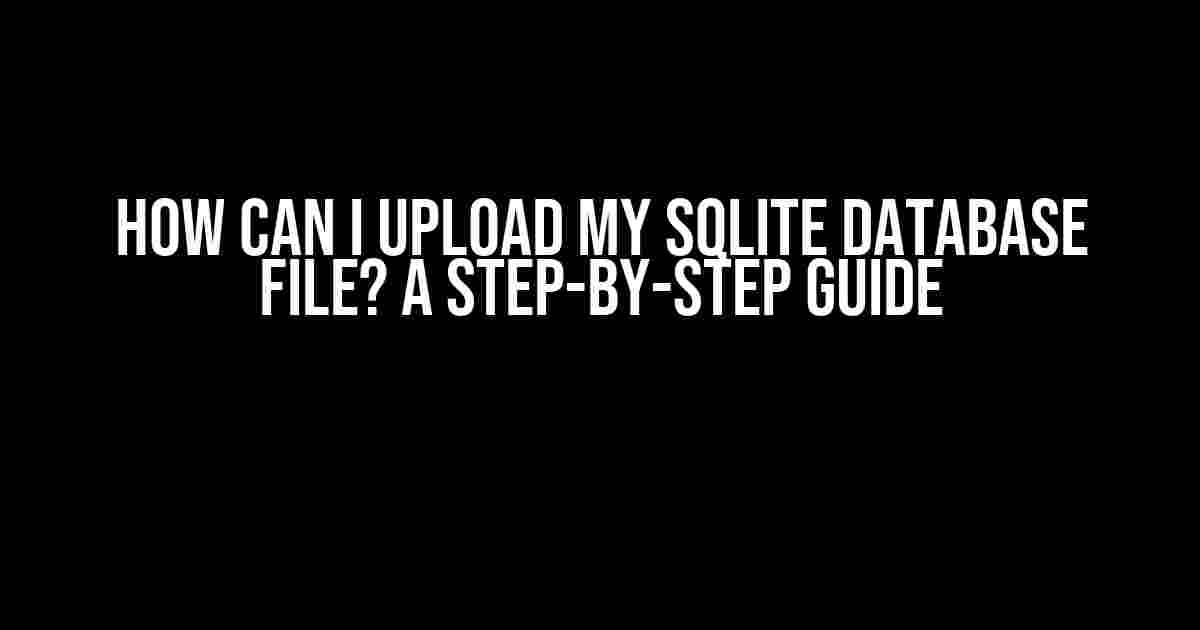Ah, the agony of trying to upload your precious SQLite database file! Don’t worry, friend, you’re not alone in this struggle. Many developers have been there, done that, and got the t-shirt. But fear not, for today we’re going to conquer this beast together! In this article, we’ll take you by the hand and guide you through the process of uploading your SQLite database file with ease. So, buckle up, and let’s dive in!
What is SQLite?
Why Do I Need to Upload My SQLite Database File?
There are several reasons why you might need to upload your SQLite database file. Maybe you want to:
- Share your database with a team or client
- Migrate your database to a new server or platform
- Backup your database for safekeeping
- Integrate your database with other tools or services
Regardless of the reason, uploading your SQLite database file can be a daunting task, especially if you’re new to database management. But don’t worry, we’ve got you covered!
Preparing Your SQLite Database File for Upload
Before we start the upload process, let’s ensure your SQLite database file is ready for prime time. Here are a few things to check:
- Make sure your SQLite database file is in the correct format (.db or .sqlite). If it’s not, you can use tools like DB Browser for SQLite to convert it.
- Verify that your database file is not corrupted or damaged. You can do this by opening the file in a SQLite client like DB Browser for SQLite or SQLite Studio.
- Consider optimizing your database file by running the
VACUUMcommand. This will help reduce the file size and improve performance.
Uploading Your SQLite Database File
Now that your SQLite database file is ready, let’s explore the various ways to upload it. We’ll cover three common methods: using a File Transfer Protocol (FTP) client, uploading to a cloud storage service, and importing into a database management system.
Method 1: Uploading via FTP Client
FTP clients allow you to transfer files between your local machine and a remote server. Here’s how to upload your SQLite database file using an FTP client:
Step 1: Download and install an FTP client like FileZilla or Cyberduck.
Step 2: Launch the FTP client and enter the hostname, username, and password for your remote server.
Step 3: Navigate to the directory where you want to upload your SQLite database file.
Step 4: Drag and drop your SQLite database file into the FTP client window or use the "Upload" button.
Step 5: Wait for the upload process to complete. Depending on the file size and connection speed, this may take a few minutes.
Method 2: Uploading to Cloud Storage Services
Cloud storage services like Google Drive, Dropbox, and Microsoft OneDrive provide a convenient way to store and share files. Here’s how to upload your SQLite database file to a cloud storage service:
Step 1: Create an account with a cloud storage service and install the desktop client or mobile app.
Step 2: Open the cloud storage client and navigate to the directory where you want to upload your SQLite database file.
Step 3: Drag and drop your SQLite database file into the cloud storage client window or use the "Upload" button.
Step 4: Wait for the upload process to complete. Depending on the file size and connection speed, this may take a few minutes.
Step 5: Share the uploaded file with others by generating a shareable link or sending an email invitation.
Method 3: Importing into a Database Management System
Database management systems like phpMyAdmin, Adminer, or Database Master allow you to import your SQLite database file directly. Here’s how to do it:
Step 1: Access your database management system and create a new database or select an existing one.
Step 2: Click on the "Import" or "Upload" button and select the SQLite database file you want to upload.
Step 3: Choose the correct database format (SQLite) and specify the file encoding (UTF-8 is usually the default).
Step 4: Click on the "Upload" or "Import" button to start the upload process.
Step 5: Wait for the upload process to complete. Depending on the file size and connection speed, this may take a few minutes.
Troubleshooting Common Issues
During the upload process, you might encounter some common issues. Here are some troubleshooting tips to help you overcome them:
| Issue | Solution |
|---|---|
| File size too large | Split the database file into smaller chunks or use a compression tool to reduce the file size. |
| Corrupted database file | Try repairing the database file using a SQLite repair tool or restoring from a backup. |
| Upload timeout | Check your internet connection and try uploading the file in smaller chunks or using a more reliable upload method. |
| File format not supported | Convert the database file to a supported format (e.g., .db to .sqlite) using a database converter tool. |
Conclusion
And there you have it – a step-by-step guide to uploading your SQLite database file! Whether you’re a seasoned developer or a newbie, we hope this article has provided you with the necessary guidance to overcome the hurdles of uploading your SQLite database file. Remember to prepare your file, choose the right upload method, and troubleshoot any issues that may arise. Happy uploading!
Do you have any questions or concerns about uploading your SQLite database file? Leave a comment below, and we’ll do our best to help you out!
Don’t forget to share this article with your friends and colleagues who might be struggling with uploading their SQLite database files. Sharing is caring!
Ready to take your database management skills to the next level? Check out our other articles on database optimization, data modeling, and more!
Happy coding, and see you in the next article!
Frequently Asked Question
Uploading your SQLite database file can be a breeze, but we know it can be a bit tricky at times. Don’t worry, we’ve got you covered! Here are some frequently asked questions to help you upload your SQLite database file with ease.
Q1: What is the recommended way to upload a SQLite database file?
The recommended way to upload a SQLite database file is to use a File Transfer Protocol (FTP) client or a Secure File Transfer Protocol (SFTP) client. You can also use a cloud-based storage service like Google Cloud Storage or Amazon S3.
Q2: Can I upload my SQLite database file directly to my website?
Yes, you can upload your SQLite database file directly to your website using a file upload feature or a Content Management System (CMS) like WordPress or Joomla. However, be sure to follow security best practices to avoid any potential risks.
Q3: What is the maximum file size limit for uploading a SQLite database file?
The maximum file size limit for uploading a SQLite database file varies depending on the hosting provider or platform you’re using. Typically, it ranges from 2MB to 100MB or more. Check your hosting provider’s documentation for specific file size limits.
Q4: Can I upload my SQLite database file to a cloud database service?
Yes, you can upload your SQLite database file to a cloud database service like Amazon Aurora, Google Cloud SQL, or Microsoft Azure Database Services. These services provide a managed database service that supports SQLite.
Q5: Do I need to compress my SQLite database file before uploading it?
It’s recommended to compress your SQLite database file before uploading it to reduce the file size and improve upload speeds. You can use tools like gzip or zip to compress your file.


